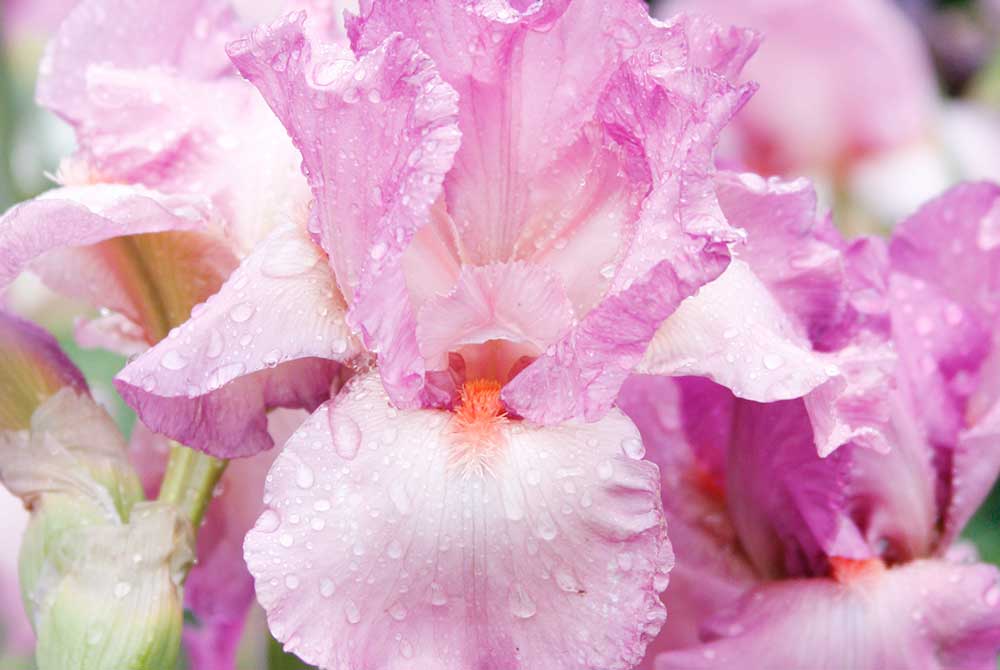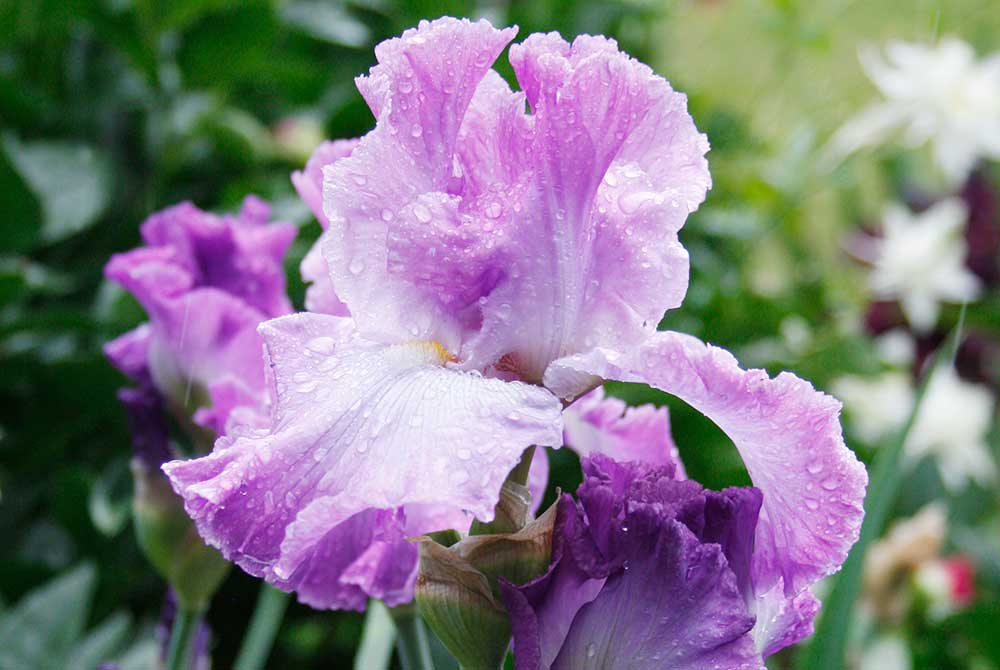Bearded Iris in all the Colors of the Rainbow!
I have always had a love-hate relationship with bearded iris. As I get older I enjoy the array of colors bearded iris offer in late spring more and more. Growing up there was always a random grouping of bearded iris planted near the peonies at my parents’ house. I believe the bearded iris were purchased by my mom from a flyer in the newspaper. The bearded iris by the peonies seemed out of place to me. Once the iris were done blooming, I wasn’t a fan of their leaves, and therefore never considered growing bearded iris myself.
When I moved out of my parents’ house I lived next to a neighbor who had a strange obsession with planting bearded iris along her chain link fence. This planting area for bearded iris also appeared out of place.
In 2013 I was fortunate to be able to travel to Schreiner’s Iris Gardens for Holland Bulb Farms to research new varieties and assist in photographing them. When I saw the bearded iris blooming in gardens in large groupings of color it changed my perspective. At the iris gardens, they were planted among late spring-blooming perennials that included poppies, peonies, and allium. When bearded iris are mixed in with other plantings they are a colorful delight in the perennial garden.
Whether you are growing bearded iris for the first time, or have an existing area of bearded iris these 6 tips will help.
1.Plant New Rhizomes in August or September for the Best Results
Bearded Iris bulbs are for sale starting in late spring for pre-order. They are available for shipping from online retailers such as Holland Bulb Farms beginning in mid-August. These perennial bulbs that grow from rhizomes are available for planting early in the season. Early season planting will help to ensure the best results for your iris plantings this year.
2 reasons you will want to plant your bearded iris rhizomes in late summer to early fall.
- Bearded Irises require at least 6 weeks before the ground freezes to establish roots to survive the winter and start taking in nutrients.
- Early season planting increases the chances of the bearded iris blooming the first season after planting exponentially. Therefore, if you want the best chance of your iris blooming the following spring, be sure to plan and plant your bearded iris in August or September.
2. Planting Location for Bearded Iris Plantings
Generally, bearded irises are easy to grow perennials once they are established. Preparation at the time of planting can have an important impact on the health and longevity of your bearded iris rhizomes.
Bearded Iris have a few requirements when it comes to their planting location. The first requirement is that they are planted in a full sun location. A full sun location is an area with 6-8 plus hours of direct sunlight per day. The second requirement is soil that drains well. If the bulbs are sitting in wet, saturated and poorly drained soil this leaves them susceptible to root rot.
Once you have a sunny location picked out, check your soil’s drainage. You will be able to tell if the soil drains well by digging a 12” deep hole and filling the hole with water. If the water takes more than 1 hour to drain from the hole, your soil is poorly drained. If your soil drains poorly you will need to enhance the soil to improve drainage.
3. How to Plant Bearded Iris
When planting your iris rhizomes planting at the proper depth is critical. The rhizome should be showing above the soil. Plant the rhizome 1-2” deep. When iris rhizomes are planted too deep, they may not grow. If the rhizomes are planted too deep this can be a reason they don’t bloom.
To enhance your soil in the bearded iris planting area, dig out the area you will be planting the rhizomes wider than the rhizome is by itself by (2-3 times the width of the rhizome). By making your planting hole larger than the rhizome it will allow for easy root penetration when the rhizomes are growing and establishing themselves. Mix your existing soil with topsoil or plant starter mix.
Adding organic matter to the planting area will help improve the soil structure, nutrient uptake, and increase the drainage. Organic matter to consider adding to your planting area would be compost from your garden, mushroom compost, peat humus, or leaf mold. Once your soil has been amended with the combination of your existing soil, topsoil, and organic matter it should be light and easy to work with. At this time you are ready to plant your bearded iris rhizomes.
4.Transplanting Iris and Divide Existing Plantings
Late summer and very early fall are the ideal times to transplant existing bearded iris plantings. Reasons to transplant bearded iris:
- The iris have overgrown their location
- They do not fit in with the surrounding plants
- Flowers are no longer forming on your bearded iris
If your bearded iris used to provide lots of flowers, and for the past year or two no longer produce heavily or at all, that is a good sign they need to be dug up and divided. When transplanting bearded iris follow the same planting instructions you would for new plantings.
5. Inspect, clean and eradicate area for Iris borers
The biggest pest of bearded iris are Iris Borers. Iris borers live underground, tunnel into the leaves, and travel down to the rhizomes and roots of the iris plants. Iris that has been attacked by the iris borer will become weak, withered, and eventually die. Disfigured, discolored leaves in early summer are a sure sign of iris borer damage. Look for dark streaks on the leaves as an indication that borers are present. Bearded iris rhizomes that are borer infected may be soft, rotten and have a foul odor.
Sanitation is the best way to control iris borers. What does sanitizing the planting area require? In fall, and into spring remove leaves from the iris. Also, remove any leaves or other debris that is surrounding the iris planting area.
Eggs for next season’s bearded iris borer live in the leaf litter, which is why it is important to remove or burn the leaves and debris that may be affected. If you are certain you have iris borer present in an existing grouping of bearded iris, once the rhizomes are removed from that area it is not suggested to re-plant new bearded iris in that area. 
6. Companion plants for Iris
Life is better with friends! Your garden will be better if your plants have friends to accentuate their best qualities. As mentioned earlier I have not always been a fan of bearded iris due to their foliage after the blooms fade. The foliage is large, green sword-like blades and can be a bit harsh in the landscape. Plant other bulbs and perennials near bearded iris to soften the harsh foliage that remains after the blooms fade.
Peonies With Bearded Iris
Spring blooming peonies pair well with bearded iris. Peonies and bearded iris bloom at the same time and the color combinations are exciting and nearly endless. Compact varieties of peony such as Plena Alba Peony can be planted in front of or staggered between bearded iris plantings. Growing only 18-24” tall the leaves of the Plena Alba Peony will help cover the foliage of bearded iris. While the glorious and colorful bearded iris blooms appear above the peony foliage.
Allium with Bearded Iris
Allium bulbs are a late spring-blooming flower bulb favorite! Coming in a variety of colors and shapes allium blooms compliment bearded iris well. Tall purple blooming allium such as Allium giganteum, Gladiator Allium and White Giant Allium look nice planted with yellow, orange, and purple bearded iris like Imbroglio, Bold Look, Avalon Sunset and Anvil of Darkness.
Oriental Poppies with Bearded Iris
Brightly colored Oriental Poppies such as Turkenlouis Oriental Poppy and Harlem Oriental Poppy can be planted in front and around bearded iris. Both poppies and bearded iris require well-drained soil in order to thrive. Therefore, this planting pair works together well.
Turkenlouis Oriental Poppy is a bright red/orange poppy, it looks best when planted with orange, white, or blue bearded iris.
Harlem Oriental Poppy has deep pink raspberry blooms. For a cool and frilly look plant Harlem Oriental Poppy with Lotus Land Bearded Iris and Winterfest Bearded Iris.
Peonies, Poppies, Allium and Bearded Iris are all best when planted in fall. This makes companion planting for these varieties convenient since the whole area can be planted at the same time. If you already have bearded iris and want to add to it, you can certainly add any of these bulbs or roots to the area as well.
For a Blooming Garden of Color Plant and Tend to Your Bearded Iris
Bearded Iris bloom in almost every color of the rainbow, there are even black iris and true blue iris. This array of colors makes them such a useful garden plant for any sunny area. My opinions have changed on bearded iris over time, at the moment I don’t have enough sun to plant them in my yard. However, in the future when I have a sunnier location I will be sure to take these 6 things into consideration when growing bearded iris.





